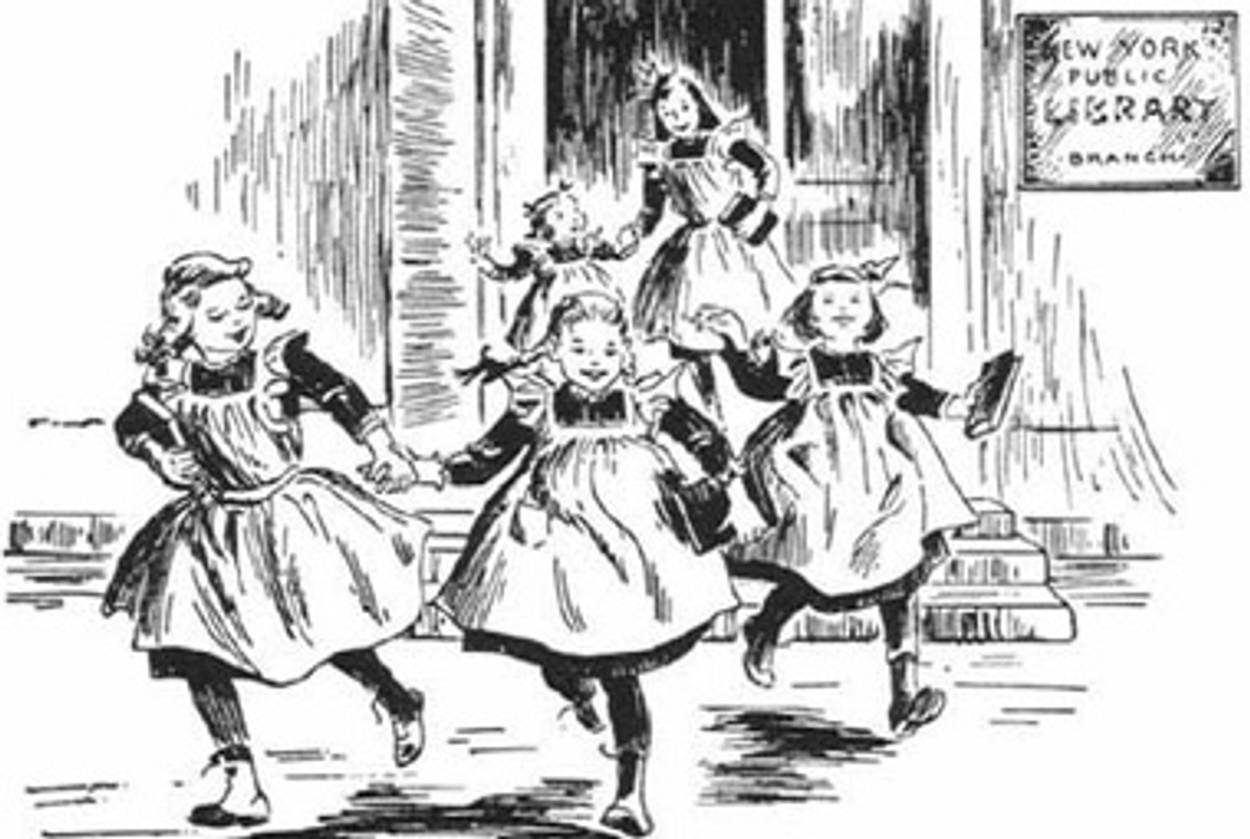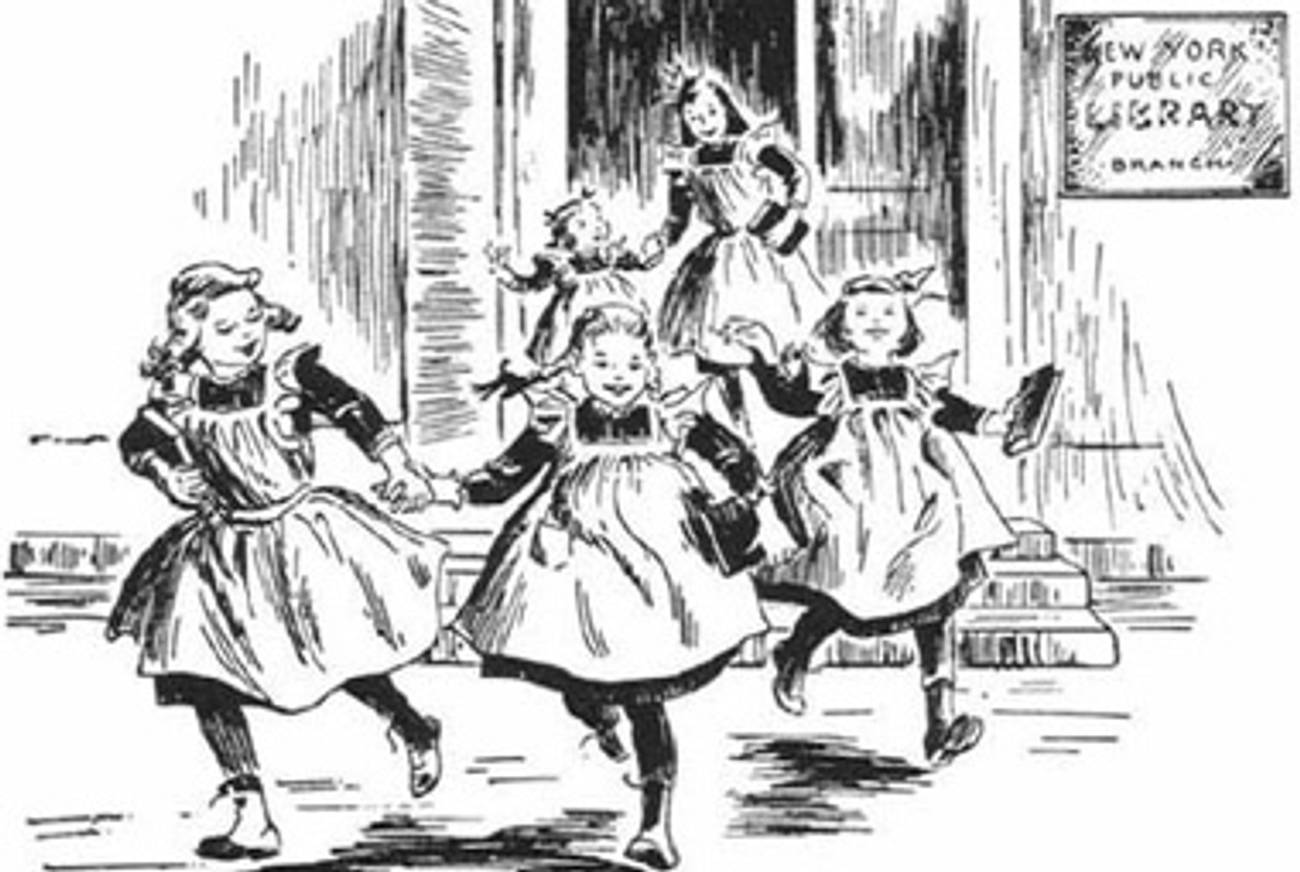We Are Family
The All-of-a-Kind Family books, marking their 60th anniversary, are a classic text of becoming American. They’re also a still-moving tribute to sisterhood.




This year marks the 60th anniversary of the publication of Sydney Taylor’s All-of-a-Kind Family. If you do not know about All-of-a-Kind Family, you either grew up on Tatooine or have a penis. All-of-a-Kind Family is the first in a series of books about five girls growing up on the Lower East Side of Manhattan in the early 20th century. Its five heroines—Ella, Henny, Sarah, Charlotte, and Gertie—are wildly different from each other: There’s the talented performer, the mischief-making rebel, the bookworm, the dreamer, the baby. No matter what kind of girl you were, you saw aspects of yourself in one of these five characters.
It’s impossible to overstate what a touchstone Family remains for book-loving American women of all ages, Jewish and not. It is on School Library Journal’s canonical list of 100 best children’s novels of all time, and the Association of Jewish Libraries has named its annual children’s book awards after Taylor. The books are deeply, powerfully loved.
There is another girl-centric ur-text about what it means to be an American: Little House on the Prairie, Laura Ingalls Wilder’s series about growing up in the Midwest in the late 19th century. In some ways Family and Little House are similar, but in other, important ways, not so much.
Both series excel at vivid descriptions of fashion and food. What could be more important to a young girl? The Little House books offer luscious and detailed accounts of calico patterns and corncob dolls; Family gives us ecru lace dresses and buttonhooks. Little House offers a roasted pig’s tail on a stick and snow candy made with maple syrup; Family gave us chocolate babies, pickles, and broken crackers from a giant barrel. I reveled in the description of the warm chickpeas Sarah bought from a street vendor:
First he took a small square of white paper from a little compartment on one side of the oven. He twirled the paper about his fingers to form the shape of a cone and then skillfully twisted the pointed end so that the container would not fall apart. He lifted the wagon cover on one side, revealing a large white enamel pot. The steam from the pot blew its hot breath in the little girls’ faces so they stepped back a bit while the peas were ladled out with a big soup spoon. The wagon cover was dropped back into place and the paper cup handled over to Sarah. The peas were spicy with pepper and salt, and how good they were!
Oh, the immediate sense of place, of things, of taste! As a little girl, I wanted those chickpeas in a cone so desperately that I forgot I hated chickpeas. Such was the descriptive power of Taylor’s writing. I think one reason male critics haven’t sufficiently appreciated AOKF is that they’re writ so small. There’s as much observing as doing. Food, fashion, and bickering—so much emphasis on girl things, girl concerns.
The same themes were evident in the Little House series, but, frankly, I always preferred Family. Sure, Taylor’s books are super Jewish while the Little House books are as goyish as mayonnaise. But it’s more than that. I’d argue that the five sisters are more vivid characters than Wilder’s Laura, Mary, and Carrie, and that the Family books more successfully strike the magical balance of being suspenseful without being too scary.
K’tonton, a book for a younger audience than Family, also manages that singular feat of being just exciting enough. But K’tonton never achieved a non-Jewish audience; Family, on the other hand, is as beloved by non-Jews as it is by Jews. It was the first crossover hit. I’d argue that in the same way the series is just scary enough, it’s also just exotic enough. A commenter responding to Lizzie Skurnick’s hilarious online appreciation of the series on Jezebel.com, titled “All-of-a-Kind Family: Where I Would Put Something Yiddish If I Thought You Goyishe Farshtunkiners Would Farshteyn,” typifies the non-Jewish response to Family: “I don’t think I knew any Jewish people when I was little, so this book meant so much because I discovered a culture that was so different from mine (little black girl living in Kensington, surrounded by my West Indian family) but was still so familiar.”
It’s true; girls of all backgrounds are fascinated by the world Family depicts. We viscerally feel the crowded busy streets, the multiethnic peddlers, and the poverty, but then we get to retreat to the cozy, loving confines of Mama and Papa’s tenement apartment. The outside world can be frightening—as it is for all children, developmentally speaking, no matter how or where they grow up—but inside is a safe space, marked by ritual objects (a fiddle in Little House, the Sabbath candlesticks in Family, in both books beautiful little objets proving a mother’s classiness) that make a house—or a log cabin, or a walkup—a home. What little girl doesn’t respond to that sense of coziness?
Among Jews specifically, though, I think Family has only gained resonance as we’ve gotten more acculturated. “While the books are about being Jewish, they are also about becoming American,” writes Taylor’s biographer June Cummins, associate professor of English at San Diego State University, in a 2003 article, “Becoming All-of-a-Kind American: Sydney Taylor and Strategies of Assimilation,” published in The Lion and the Unicorn, an academic journal dedicated to children’s literature. “As with any other immigrant group, the relationship between two identities, one associated with another country or culture and the other with America, produces a tension not easily, if ever, resolved.”
So many of us struggle with how Jewish to be. I feel it acutely, living as I do in Taylor’s old neighborhood. My girls walk to the library before Shabbat, just as Taylor’s girls do. We spend a lot of time at the Henry Street Settlement, only instead of meeting a nurse who helps poor Guido, we see Nutcracker in the Lower, a hip-hop and flamenco-inflected version of Tchaikovsky’s ballet. I live in a constant state of balance, wanting my public-school-educated children to feel joyfully Jewish but also part of the wider culture.
Taylor would have understood. By the time she wrote the books, Cummins tells me, Taylor no longer kept kosher, observed Shabbat, or celebrated most of the Jewish holidays she wrote about. Neither did the vast majority of American Jews. Yet Taylor wanted her daughter, and other children, to feel connected to their collective American past.
The tension between Jewishness and Americanness that makes the books feel so rich was a product of the intense back-and-forth relationship between Taylor and her editor, Esther Meeks, who consistently pressured Taylor to make the books less Jewish. Cummins quotes a December 28, 1950 letter to Taylor from Meeks: “I do think it important, too, particularly today, that this family show some signs of being American as well as Jewish.” Cummins posits that the “particularly today” refers to the arrest and trial of Julius and Ethel Rosenberg, which happened as the book was being written.
Perhaps because of Taylor’s awareness of Jews’ precarious position in American society, her books address otherness with the kind of care and nuance the Little House books lack. It can be hard to revisit the Little House books as an adult. Much has been written about the anti-Indian racism and sense of white entitlement these books depict. The AOKF books, on the other hand, portray an America in which many people of different backgrounds have to learn to get along and help each other. Where Ma Ingalls detests and scorns the Indians, AOKF’s Mama spares some of the family’s meager funds to help non-Jews. The family constantly praises the efforts of settlement house workers to help everyone. “There are exceptional people in this world whose hearts are big,” Mama tells Ella. “They really care about what happens to others. It’s people like that who started the settlement house.” Yes, the books contain ethnic stereotypes (the peddlers of many nations who schmooze and rest in Papa’s junk shop are about as nuanced as the Racing Sausages entertaining the crowds at Milwaukee Brewers games), but ultimately they’re embracing of difference and hopeful about the notion of diverse urban community.
But there’s the political and there’s the personal. While I loved the fashion and food and Jewishness and historicity and rich detail of the AOKF books, what made them indelible to me was something else. These five girls—sharing a bedroom, whispering late into the night, getting into scrapes and making up—felt like the sisters I never had and wished I did. Sure, the books were exciting, and sure, it’s wonderful to share the stories I loved with my own daughters, who love them just as much as I do. But ultimately, what I love about these books is that they’re about sisterhood. And that’s powerful.
Marjorie Ingall is a columnist for Tablet Magazine, and author of Mamaleh Knows Best: What Jewish Mothers Do to Raise Successful, Creative, Empathetic, Independent Children.
Marjorie Ingall is a former columnist for Tablet, the author of Mamaleh Knows Best, and a frequent contributor to the New York Times Book Review.